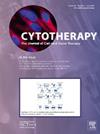A Multifunctional Microfluidic Device for Tailoring Analytical Assay Development for Multiproduct Cell Therapy Products (CTPs)
IF 3.2
3区 医学
Q2 BIOTECHNOLOGY & APPLIED MICROBIOLOGY
引用次数: 0
Abstract
Background & Aim
The rising demand for cell therapies necessitates innovative tools to streamline analytical development & QC assays. We propose a microfluidic device to transform analytical workflows by handling small samples, reducing reagents, & automating processes.
Methodology
This device minimizes reagent requirements while maintaining high throughput, enabling cost-efficient and scalable processes. Its microfluidic architecture precisely manipulates & separates T cells from whole blood samples, reducing sample volume significantly compared to conventional methods. Beyond T cell isolation, the device integrates a multifunctional platform capable of performing analytical assays, including ELISA, effectively replacing traditional 96-well plates. This integration enhances its utility by enabling real-time cytokine profiling, immunophenotyping, high-sensitivity biomarker detection, single-cell analysis & multiplexed assays on a single platform.
Results
The design of this microfluidic device was developed after thorough review of existing literature & iterative modifications. Key considerations included device dimensions, operational sequences, particle size compatibility, reagent material compatibility, hydrophobicity, and detection sensitivity. The final configuration comprises two pairs of hexagonal channels connected via one inlet and two outlets, utilizing a herringbone structure to optimize cell capture & retention. This structure disrupts flow, increasing turbulence & enhancing cell interaction with channel surfaces. The device leverages microfluidic principles, manipulating fluid behavior using microliter to picoliter volumes with channel dimensions in the micrometer range. It adheres to the Hele-Shaw flow property, defined as Stokes Flow between two parallel plates separated by a narrow gap, ensuring laminar flows with low Reynolds numbers. Fabricated from advanced polymers like PDMS and PMMA, the device ensures durability, biocompatibility, and seamless integration with automated workflows. It supports parallel processing of multiple samples, reducing assay time while maintaining precision and reproducibility. The system is compatible with existing laboratory tools like flow cytometry & imaging systems, enabling effortless adoption in clinical and industrial settings.
Conclusion
By combining versatility, scalability, and cost-efficiency, this microfluidic system represents a robust platform for CAR T analytical development, poised to advance the manufacturing and QC landscapes of CGT.
用于多产品细胞治疗产品(ctp)裁剪分析试验开发的多功能微流控装置
背景,目的对细胞疗法不断增长的需求需要创新的工具来简化分析开发。质量控制分析。我们提出了一种微流控装置,通过处理小样品,还原试剂,&;自动化流程。该设备最大限度地减少试剂需求,同时保持高通量,实现成本效益和可扩展的过程。它的微流控结构精确地操纵从全血样本中分离T细胞,与传统方法相比,大大减少了样本量。除了T细胞分离外,该设备还集成了一个多功能平台,能够进行包括ELISA在内的分析分析,有效地取代了传统的96孔板。这种整合通过实现实时细胞因子分析、免疫分型、高灵敏度生物标志物检测、单细胞分析等,增强了其实用性。在单一平台上进行多路分析。结果该微流控装置的设计是在对现有文献进行了深入的研究后开发的;迭代修改。主要考虑因素包括设备尺寸,操作顺序,粒度兼容性,试剂材料兼容性,疏水性和检测灵敏度。最终配置包括两对六角形通道,通过一个入口和两个出口连接,利用人字形结构来优化细胞捕获&;保留。这种结构破坏了流动,增加了湍流。增强细胞与通道表面的相互作用。该装置利用微流体原理,使用微升到皮升的体积和微米范围内的通道尺寸来操纵流体行为。它遵循Hele-Shaw流动特性,定义为由狭窄间隙分隔的两个平行板之间的斯托克斯流动,确保了低雷诺数的层流。该设备由PDMS和PMMA等先进聚合物制成,可确保耐用性、生物相容性以及与自动化工作流程的无缝集成。它支持多个样品的并行处理,减少分析时间,同时保持精度和再现性。该系统兼容现有的实验室工具,如流式细胞仪;成像系统,使临床和工业环境中轻松采用。该微流控系统结合了多功能性、可扩展性和成本效益,为CAR - T分析发展提供了一个强大的平台,有望推动CGT的制造和质量控制领域的发展。
本文章由计算机程序翻译,如有差异,请以英文原文为准。
求助全文
约1分钟内获得全文
求助全文
来源期刊

Cytotherapy
医学-生物工程与应用微生物
CiteScore
6.30
自引率
4.40%
发文量
683
审稿时长
49 days
期刊介绍:
The journal brings readers the latest developments in the fast moving field of cellular therapy in man. This includes cell therapy for cancer, immune disorders, inherited diseases, tissue repair and regenerative medicine. The journal covers the science, translational development and treatment with variety of cell types including hematopoietic stem cells, immune cells (dendritic cells, NK, cells, T cells, antigen presenting cells) mesenchymal stromal cells, adipose cells, nerve, muscle, vascular and endothelial cells, and induced pluripotential stem cells. We also welcome manuscripts on subcellular derivatives such as exosomes. A specific focus is on translational research that brings cell therapy to the clinic. Cytotherapy publishes original papers, reviews, position papers editorials, commentaries and letters to the editor. We welcome "Protocols in Cytotherapy" bringing standard operating procedure for production specific cell types for clinical use within the reach of the readership.
 求助内容:
求助内容: 应助结果提醒方式:
应助结果提醒方式:


